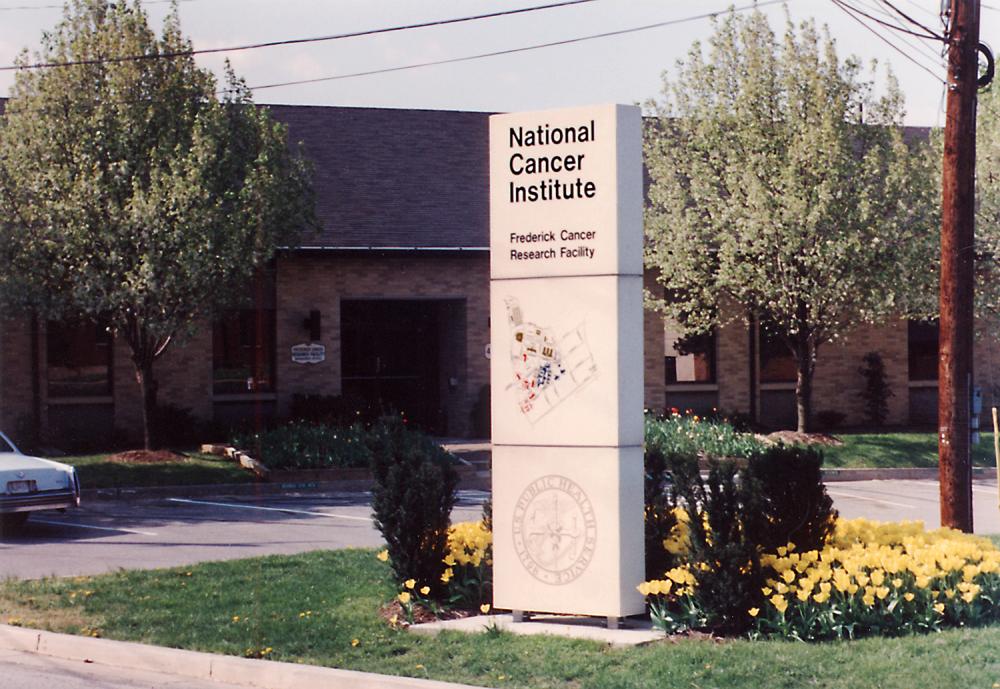By Carolynne Keenan, Guest Writer
Forty years ago, a single act by former President Richard Nixon created what we now know as the Frederick National Laboratory for Cancer Research (FNL) at Fort Detrick. What began as a small facility with a staff of about 20 people in the early 1970s grew into the multi-facility, nationally distinguished laboratory for cancer research that it is today.
FNL may have changed names a few times over the years, with the most recent change in March 2012, but even through the changes, the mission has been the same: to speed the translation of laboratory research into new diagnostic tests and treatments for cancer, AIDS, and other infectious diseases.
FNL has spent many of the last 25–30 years “putting its resources into place to serve the nation in general,” said Craig Reynolds, Ph.D., director, Office of Scientific Operations, FNL.
Many discoveries have been made over the years in developing treatments for cancer, AIDS, and other infectious diseases. In the early 1980s, FNL (then known as the Frederick Cancer Research Center) played a part in developing a blood test to protect the nation’s blood supply from HIV infection.
Significant Programs and Discoveries
The Biopharmaceutical Development Program (BDP), which was established in 1993, produces biological agents for NCI-supported intramural and extramural clinical trials. Since its creation, BDP has created more than 100 products. Of that, more than 70 have gone into clinical trials. One such example is interleukin-2 (IL-2), which has been used to treat melanomas and kidney cancer, and is being studied to treat other types of cancers, according to the BDP website and staff.
“I have been with the BDP since its inception in 1993 and have been fortunate to be able to see the program fully develop into a great asset for getting biopharmaceuticals into clinical trials,” said Beverly Keseling, Ph.D., a scientist in BDP. “Some of the therapeutic proteins we have manufactured have rewarded us in becoming effective cancer treatments.”
Fellow scientist Yueqing Xie, Ph.D., agreed. “I am proud to be part of a wonderful team that has successfully made clinical supplies for many first-in-human clinical trials for the treatment of cancer and other diseases.”
The Vaccine Pilot Plant (VPP) has significantly increased the nation’s capacity to produce vaccines for emerging infectious diseases, including SARS and some strains of the flu, Reynolds explained. VPP opened in 2006 and is a joint collaboration between NCI and the National Institute of Allergy and Infectious Diseases.
Another highly rated program is the Nanotechnology Characterization Laboratory (NCL). Established in 2004, it is an interagency collaboration between NCI, the National Institutes of Standards and Technology, and the Food and Drug Administration. NCL’s mission is to accelerate the translation and development of new nanotech cancer drugs and diagnostics by performing preclinical characterizations.
Jennifer Grossman, Ph.D., an NCL scientist, explained the role NCL plays in cancer research. “Chemotherapy—treatment with cytotoxic chemicals—is still the cornerstone of most cancer treatment. Nanotechnology—manipulation of matter at the nanoscale size range—is one way scientists are trying to improve chemotherapeutics.”
Other scientific discoveries have happened along FNL’s 40-year journey. In 2005, Ligia Pinto, Ph.D., and her staff in the HPV Immunology Laboratory developed a cervical cancer vaccine that was tested in Phase III clinical trials and is now available nationwide. In 2011, a patent was issued for human monoclonal antibodies that may treat patients infected with deadly Hendra and Nipah viruses. Scientists in the Nanobiology Program were involved in the research that led to this groundbreaking development.
FNL continues to make history in the search for better treatments for cancer and AIDS.
Carolynne Keenan is a public affairs specialist in the Office of Scientific Operations, FNL.


